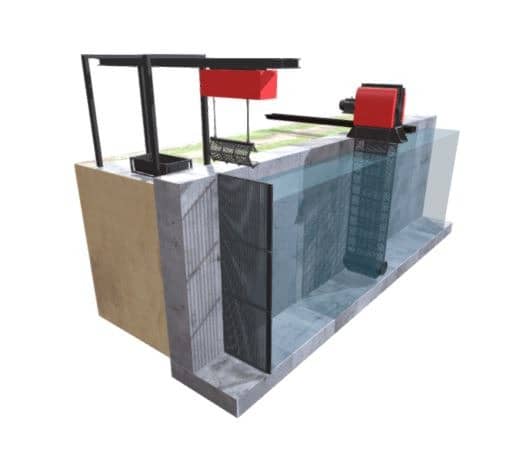Introduction
Water intakes must be able to handle large volumes of unfiltered water. This 3D model shows a water intake used for plants utilising a large amount of influent e.g. desalination plants, water treatment plants etc.
Trash Rack
The trash rack consists of fixed metal bars installed perpendicular to the influent flow direction; the bars are known as the bar screen. The bar screen utilises a rake for cleaning purposes and the rake and bar screen together form the trash rack.
How It Works
A trash rack is for coarse filtering only. The purpose of the bar screen is to filter large foreign bodies from the influent. Typical items filtered by the screen include seaweed, plastic bags and tree branches etc.
Once the foreign bodies have been retained by the bar screen, a rake is lowered to the base/foot of the bar screen and the debris is scraped from the bar screen as the rake is raised again. The rake then travels transversely and discharges the debris into a waste hopper.
Purpose
The trash rack prevents large pieces of debris damaging equipment further downstream i.e. pumps, travelling screens etc. As debris can sometimes be quite large, the bar screen and rake must be suitably sized.
Travelling Screen
After the influent has been coarse filtered, it is then further filtered to protect downstream components such as pumps. Travelling screens provide continual fine filtering and can remain in service for long periods as they are self-cleaning. Three main types of travelling screen are commonly employed, thru/through flow, centre flow and dual flow; this 3D model shows a through flow design.
Construction
A travelling screen consists of a series of mesh basket screens connected together using a carrier chain. Two gears are used at the top (head) and bottom (foot) of the screen in order that the screen can form a continuous loop. A standard three phase electric motor is used to drive the screener; this can be done directly or indirectly using gears or a pulley.
How It Works
The travelling screen is installed perpendicular to the influent’s flow direction. Foreign bodies not small enough to pass through the screen become entrained on the screen’s outer surface. The screen then carries the bodies upwards and rotates around the head sprocket. Spray nozzles then spray water onto the reverse (inner) side of the screen to remove the entrained foreign bodies. Usually, the foreign bodies are discharges directly to a fast flowing waste trough. Water flowing through the waste trough carries the foreign bodies to the waste area; this is an area away from the intake area.
Related Online Engineering Courses
How Fresh Water Generators Work
Water Treatment and Demineralization
Additional Resources
https://encyclopedia2.thefreedictionary.com/Water+Intake+Works
https://theconstructor.org/structures/intake-structures-types-of-intakes/11233
